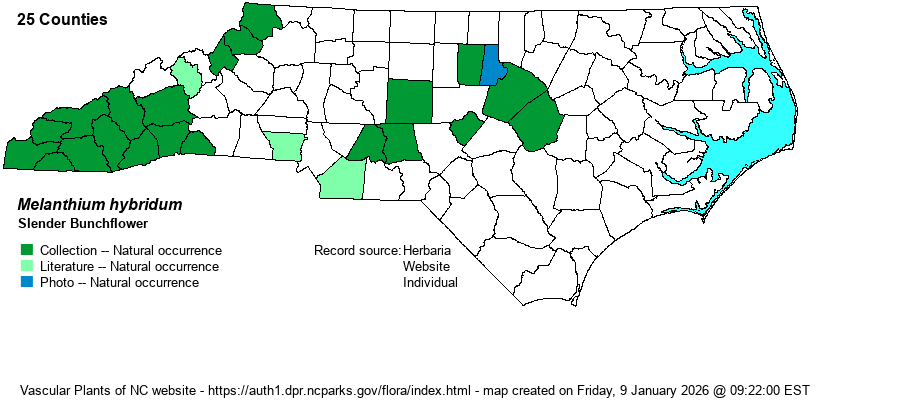| Section 5 » Family Melanthiaceae |
Show/Hide Synonym
| taxonName | relationship | relatedTaxonName | relatedTaxonRefText | relComments |
|---|
|
|
|
|
|
|
| Melanthium hybridum | = | Melanthium latifolium | Flora of North America (1993b, 1997, 2000, 2002a, 2002b, 2003a, 2004b, 2005, 2006a, 2006b, 2006c, 2007a, 2009, 2010) | | | Melanthium hybridum | = | Melanthium latifolium | | | | Melanthium hybridum | = | Melanthium latifolium | Small (1933, 1938) | | | Melanthium hybridum | = | Veratrum hybridum | | | | Melanthium hybridum | = | Veratrum hybridum | Flora of Virginia | | | Melanthium hybridum | = | Veratrum hybridum | Zomlefer et al. (2003). | | | Melanthium hybridum | = | Veratrum latifolium | | | | Melanthium hybridum | = | Veratrum latifolium | | | | Melanthium hybridum | = | Veratrum latifolium | Zomlefer et al. (2003). | | | Source: Weakley's Flora |
|
| Author | Walter | |
| Distribution | Nearly throughout the Mountains, and disjunct eastward to the central and eastern Piedmont. Seemingly absent in the western half of the Piedmont, certainly not an artifact of collecting, though a few scattered records from this large region would be expected.
This Eastern species has a somewhat limited range, ranging north to southern NY and adjacent CT, south mainly through the Appalachian mountains to northern GA. There are only scattered records into the Piedmont and Coastal Plain, south to central GA and central AL. It is absent in OH, KY, and states farther to the west. | |
| Abundance | Scarce in the state; generally uncommon in the southern Mountains, and rare in the northern Mountains. Rare and declining in the eastern half of the Piedmont, where quite difficult to find now. Newly discovered in 2017 in Lee County at San-Lee County Park by Jimmy Randolph. | |
| Habitat | This is a forest-based species, usually found on mesic slopes that have moderate to high pH soils. It is not truly a Rich Cove Forest species, though it can be seen there. It can be found in somewhat dry forests, including semi-shaded roadbanks, but where the soil is circumneutral. | |
| Phenology | Blooms in July and August, and fruits in September and October. | |
| Identification | This is a striking and stately species when in bloom. It has long and somewhat slender basal leaves in a clump; these leaves are up to 2 feet long, but are narrowly elliptic to oblanceolate, as opposed to linear, usually more than 1.5 inches wide. The flower stalk is a wide-branching panicle up to 3-4 feet tall, with a few dozen fairly large whitish flowers. Each flower is roughly 3/4-inch across but is quite unusual. The six tepals have long claws (narrowed stalk), and the remainder of the tepal is rather rounded but crinkled, with wavy margins that give the flower a "papery" look to them, a bit reminiscent of a small white Crape-myrtle (Lagerstroemia indica) flower! The other species in the genus have tepals that are entire, elliptical, and flattened into a single plane, giving a more "normal" look to a flower. Of course, a number of other monocot species have a basal clump of long but narrow to fairly narrow leaves, and thus nearly all people will need to see this scarce species in bloom to identify it. Your best bet to see it would be to visit the southern mountains in late summer. | |
| Taxonomic Comments | This species has had several name changes, from M. hybridum to M. latifolium to Veratrum hybridum or V. latifolium, but back to M. hybridum again (as in Weakley 2018). Its status as a good species has not been questioned, just its placement in genus and species.
| |
| Other Common Name(s) | Crisped Bunchflower | |
| State Rank | S3 | |
| Global Rank | G5 | |
| State Status | | |
| US Status | | |
| USACE-agcp | | |
| USACE-emp | | |

